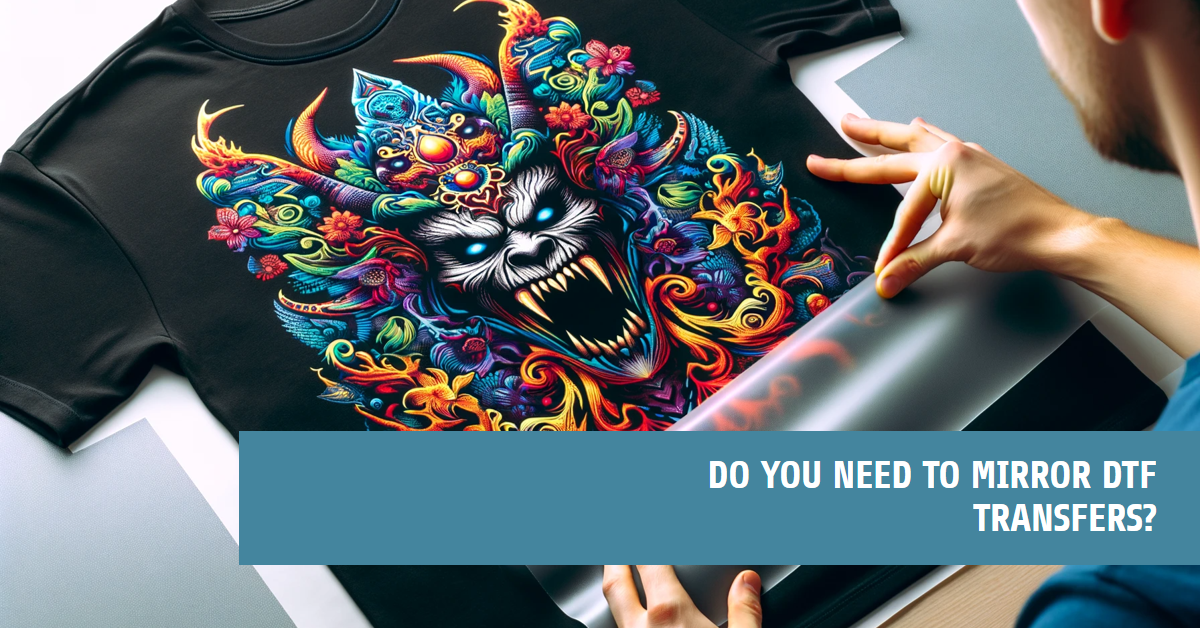DTF (Direct To Film) graphics are a breakthrough in digital design. They're printed on a special transfer film and then heat-pressed onto garments or other items. With its ability to deliver vibrant, full-color prints on variety range of materials, making custom DTF transfers a favorite choice.
But here's a common question: Should DTF images be mirrored before printing?
In this guide, we'll break down when you should mirror your DTF images and when you can skip it. Plus, we'll walk you through the easy steps to mirror artwork using CAD link software for DTF printing. Let's dive in and simplify the process for you!
What are DTF Images?
DTF (Direct-to-Film) images are a type of printing technology that allows for high-quality, full-color prints to be made directly onto a thin, flexible film. This film can then be applied to a variety of materials, including fabrics, plastics, and metals, creating a durable and long-lasting image.
But here's the best part: DTF isn't just about looks. It promises durability. Say goodbye to faded logos or graphics that crack and peel after a few washes. With DTF, your designs stay as fresh and vivid as the day they were printed, wash after wash.
So, whether you're a business aiming for top-notch branding or an individual looking for lasting prints, DTF is the choice for you. Dive into the future of printing with DTF and let your designs truly come to life!
Do you Need to Mirror DTF Images?
When using DTF transfers, always remember to flip or mirror your image horizontally before printing. Because the image gets transferred in reverse onto the final item. So, to make sure your design looks right, especially if it has text or logos, you need to mirror it first. Think of it like this you're printing onto a clear film with a special ink. This film then goes onto your chosen product, and with a bit of heat, your design transfers onto it.
If you forget to mirror, your design will appear backwards on the final product, which isn't ideal. Thankfully, most design software like Adobe Photoshop or Illustrator has a handy "flip horizontal" or "mirror" feature. Always give it a quick check before printing to ensure perfection in your final piece.
Why Do You Need to Mirror DTF Images?
Ever wondered why DTF (direct-to-film) transfers often look like they're in reverse? When printing with DTF, it's crucial to remember the mirroring step. Here's why:
When you print an image directly onto the glossy side of a DTF film, it's essentially a mirror image of what you want on the fabric. During the transfer process, this image gets reversed again, ensuring that the final print on your fabric is in the correct orientation. If you miss this step, you might end up with a backward logo or text!
However, there's a small catch. If your design is symmetrical or doesn't have a specific direction (like certain patterns or shapes), you can skip the mirroring step. But for most designs, especially those with text or distinct graphics, mirroring is a must.
So, the next time you're gearing up for a DTF print, remember to check your design's orientation. A simple mirroring step can make all the difference between a perfect print and a backward blunder.
When Can You Skip Mirroring in DTF Printing?
While DTF (direct-to-film) printing typically requires you to mirror the image before printing, there are exceptions to this rule. So, when can you bypass this step.
Symmetrical Designs: If your design is the same on both sides, like a perfectly symmetrical butterfly or a circle, there's no "right" or "wrong" way for it to face. Hence, mirroring isn't necessary.
Non-Directional Patterns: Some designs don't have a specific orientation. Think of abstract patterns, random dots, or certain floral prints. For these, it doesn't matter which way they face, so you can skip the mirroring step.
However, for the majority of DTF prints, especially those with text, logos, or distinct graphics, mirroring is crucial. This ensures that when the image is transferred from the film to the fabric, it appears as intended and not backward.
What Software Can be Used to Mirror DTF Images?
Mirroring images is a crucial step in the DTF (Direct to Film) printing process. Thankfully, several software options can help you achieve this with ease:
CADlink Software: A versatile tool for DTF printing, CADlink offers straightforward mirroring options. Whether you're looking to modify an existing design or starting a new project, you can easily mirror your image. Simply navigate to the modify option, the job tab, or the print section, among other methods, to enable mirroring.
EZ RIP PRO: Tailored for DTF printing, EZ RIP PRO simplifies the mirroring process. Within the "RIP (Print Options)" panel, you'll find a "Mirror/Invert Image" option. Just check this box, and your image will be mirrored, ready for printing.
Specialized RIP Software: RIP, or Raster Imaging Processor software, plays a pivotal role in DTF printing. Not only does it help in mirroring, but it also optimizes print performance, manages ink droplet sizes, and ensures color accuracy. There are numerous RIP software options available, each with its unique features tailored for DTF printing.
Do you mirror an image for light transfer paper?
Yes, when using light transfer paper, it's essential to reverse the image and print it in mirror mode. This way, when you place the transfer paper face down on the garment, the image will appear correctly oriented after the transfer process is complete.
Do you mirror an image for dark transfer paper?
No, there is no need to mirror or reverse the image before printing. Once your design is printed on dark transfer paper, trim around the design, leaving a small tab to make peeling easier later on.
What are the Steps to Enable Mirroring Using CADLink Software?
Mirroring an image in CADLink Software is a simple process that can be done in just a few steps. Here's how to do it:
Method 1:
- Click on the artwork you want to mirror.
- Right-click and select Modify.
- Click Mirror.
Method 2:
- Make sure the Job tab is selected.
- Click the Mirroring button.
Method 3:
- Go to Devices > Manage Print Modes.
- Double-click on the print mode you want to enable mirroring for.
- Select the Color Layer tab.
- Underneath Layer Profile, select the Mirror Vertically or Mirror Horizontally checkbox.
- Click Save and close the window.
- Once you have enabled mirroring, any artwork you drag and drop into CADLink will be mirrored automatically.
Some Additional Notes About Mirroring in CADLink:
- Mirroring can be applied to both individual artwork elements and to entire jobs.
- Mirrored artwork can be flipped either vertically or horizontally.
- Mirroring can be enabled or disabled for specific print modes.
- If you are using mirroring with a direct-to-film (DTF) printer, make sure that the mirror image is facing the correct direction before printing.
How to Mirror Image in Canva?
To mirror an image in Canva, simply select the image, click the "Flip" button in the toolbar, and choose either "Flip horizontal" or "Flip vertical" depending on the desired effect. Here are some steps so you can understand it easily.
Open Canva: Start by either creating a new design or opening an existing one.
Upload Your Image: Navigate to the "Uploads" tab on the left side of the screen. Click on it, and either select an image from your existing uploads or upload a new one by clicking "Upload files."
Add Image to Canvas: Drag the uploaded image onto your design canvas.
Select the Image: Click on the image to select it. This will reveal the editing options in the top toolbar.
Flip the Image: Look for the "Flip" option in the toolbar. Click on it to see two options: "Flip horizontally" and "Flip vertically." Choose "Flip horizontally" to create a mirror effect of the image. If you prefer to flip it vertically, select that option instead.
Finalize Your Design: Once you are satisfied with the mirrored image, you can download or share your design as needed.

